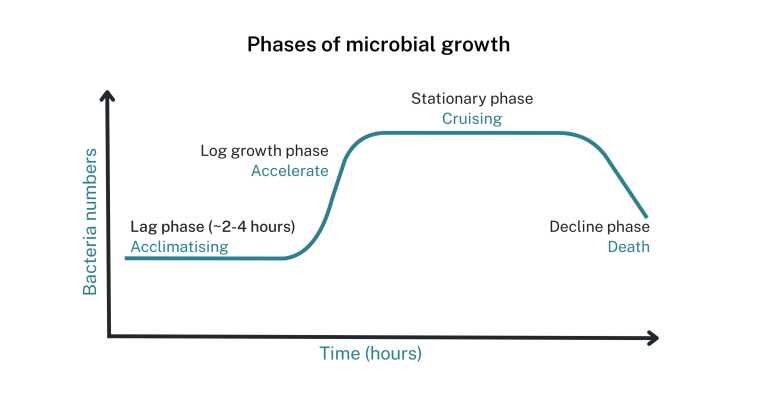
- Print this page
- Download as PDF
- Share this page
A common cause of foodborne illness is bacteria (pathogenic microorganisms) in food. When bacteria grow to large numbers they can make people sick.
Bacteria can only grow in certain conditions. These conditions, or factors for growth, are commonly referred to by the acronym ‘FATTOM’:
- Food
- Acidity
- Time
- Temperature
- Oxygen
- Moisture
Foods that provide a favourable environment for bacteria to grow are known as potentially hazardous foods (PHF); they are generally moist, nutrient-rich foods with a neutral pH.
If one of the above 6 conditions above is removed, for example if the food is kept cold in a fridge, cooked thoroughly, or if other ingredients are added to change the pH, most bacteria will not grow and thrive.
Food
Bacteria require nutrients, such as proteins and sugars, to grow.
Protein-rich foods like meat, milk, eggs and fish provide excellent sources of nutrients for bacteria and promote their growth.
Acidity
The acidity or pH (potential hydrogen) of food significantly affects the rate of microbial growth.
pH is measured using a range of 0-14, with 7 being neutral, less than 7 indicating acidity and greater than 7 indicating alkalinity.
Near neutral pH conditions (6.6 - 7.5) provide for optimal bacterial growth. Foods in this range include camembert cheese, fresh fish and chicken.
Most meats, fish and vegetables are slightly acidic, while many fruits are moderately acidic. Most bacteria can't grow at pH less than 4.6, although some can survive acidic conditions – for example, Salmonella can grow at a pH as low as 3.8.

The examples provided above are general and for illustration. Often foods have a range of possible pH values, so accurate testing is essential in food production if relying on pH to prevent microbial growth.
Temperature
Almost all types of bacteria can only grow at temperatures between 5°C and 60°C. This range is known as the temperature danger zone. The optimal temperature for bacterial growth is at room and body temperature (21°C to 49°C).
If the food provides a suitable environment, and it is not kept under temperature control (either below 5°C or above 60°C), bacteria can grow and reach unsafe levels.
Most pathogenic bacteria (those that cause illness) are killed by cooking.
Once cooked, potentially hazardous food (like egg or meat dishes) needs to be cooled or reheated quickly. Some microorganisms produce heat-resistant spores. If food isn’t cooled quickly, these spores can germinate and grow and may even produce heat stable toxins which can’t be destroyed by reheating.
Refrigerating or freezing food does not kill bacteria – it only slows or stops their activity. There are exceptions such as Listeria, which can grow (albeit very slowly) in refrigerated food.
Time
Bacteria take time to grow to high enough numbers to cause illness. It can take up to 4 hours for bacteria cells to adapt to their environment.
Under ideal conditions, some bacteria can then double in numbers every 20 minutes. During this exponential growth, there can be millions of cells produced, enough to cause illness.
The longer bacteria are permitted to grow, the more they increase in numbers. Reducing the time potentially hazardous foods spend in the temperature danger zone between 5°C-60°C is crucial for safety.
The evidence-based ‘2-hour/4-hour rule’ (PDF, 260 KB) outlines the time potentially hazardous food can be safely held between 5°C and 60°C.
Four phases of microbial growth
- Lag phase: No apparent growth as the cells adapt to their environment. This lasts for about 4 hours.
- Log phase: Rapid growth as bacteria double in numbers every 20 minutes in ideal conditions.
- Stationary phase: As cell mass becomes large, nutrients are exhausted and metabolic waste products accumulate. Bacterial growth slows and the population remains constant for a time.
- Decline phase: With no intervention the total numbers of organisms eventually decline.

Oxygen
Almost all foodborne pathogens are aerobic that is, they require oxygen to grow. However, some bacteria are:
- anaerobic organisms - can grow without oxygen - some can only grow in the absence of oxygen (obligate anaerobes)
- facultative bacteria - can grow with or without oxygen
- microaerophilic bacteria - grow in small amounts of oxygen.
Moisture
Water is essential for the growth of foodborne pathogens.
The amount of water available for microbial growth in a food is called water activity (aw). It is measured on a scale of 0 to 1.0; pure water is aw 1.0.
Foodborne pathogens grow best in foods that have an aw between 0.86 and 1.0.
Foods with an aw of 0.85 or less, such as dry goods, salted dried meats and biscuits, suppress the growth of pathogenic bacteria. The bacteria Staphylococcus aureus is used as a ‘benchmark’ where its minimum aw for growth is 0.83.
Related information
- Foodborne illness pathogens
- Potentially hazardous foods (PDF, 352 KB)
- Managing potentially hazardous foods
- Cooling potentially hazardous food (PDF, 221 KB)
- 2-hour / 4-hour rule fact sheet (PDF, 170 KB)
- Guidance on the 2-hour / 4-hour rule (PDF, 806 KB)
